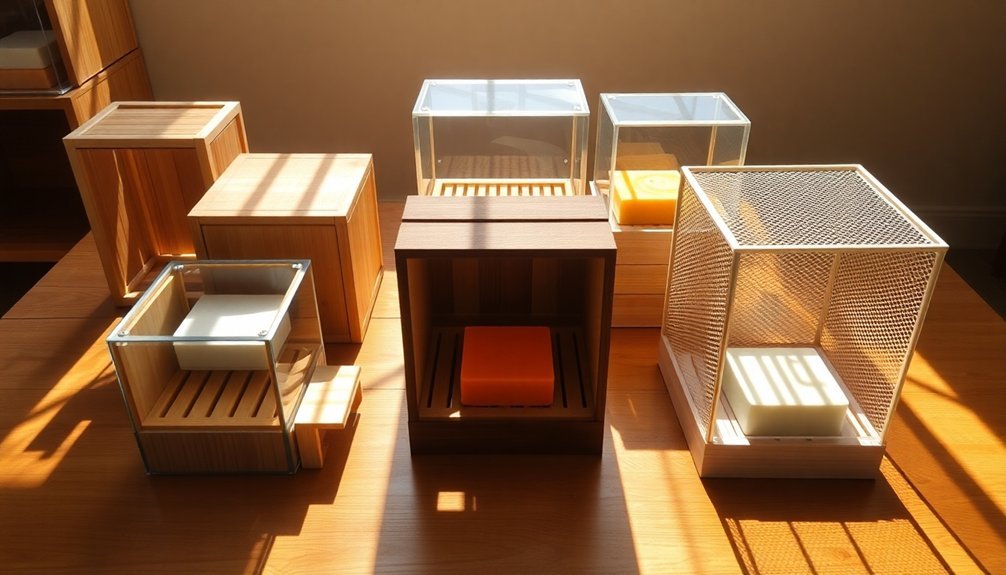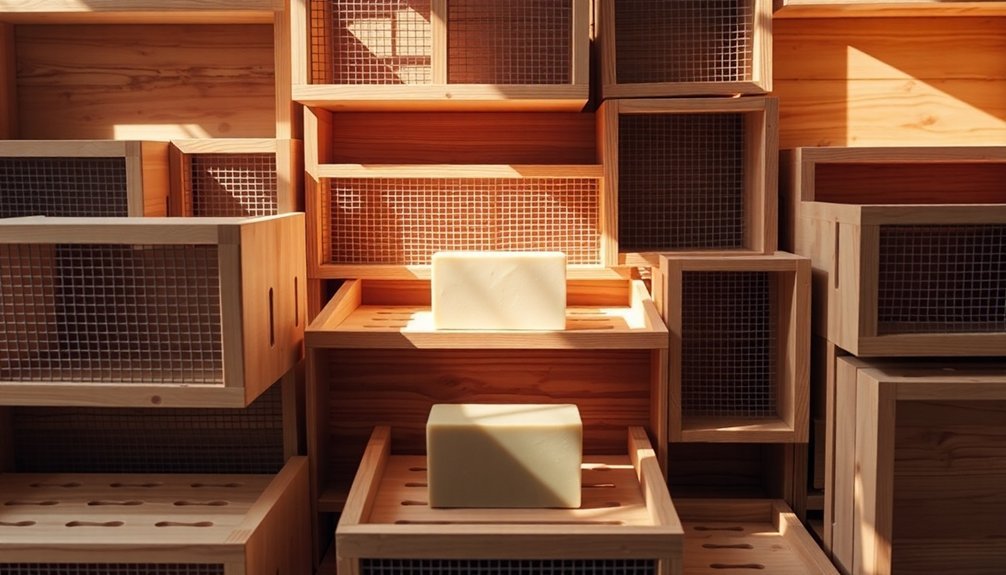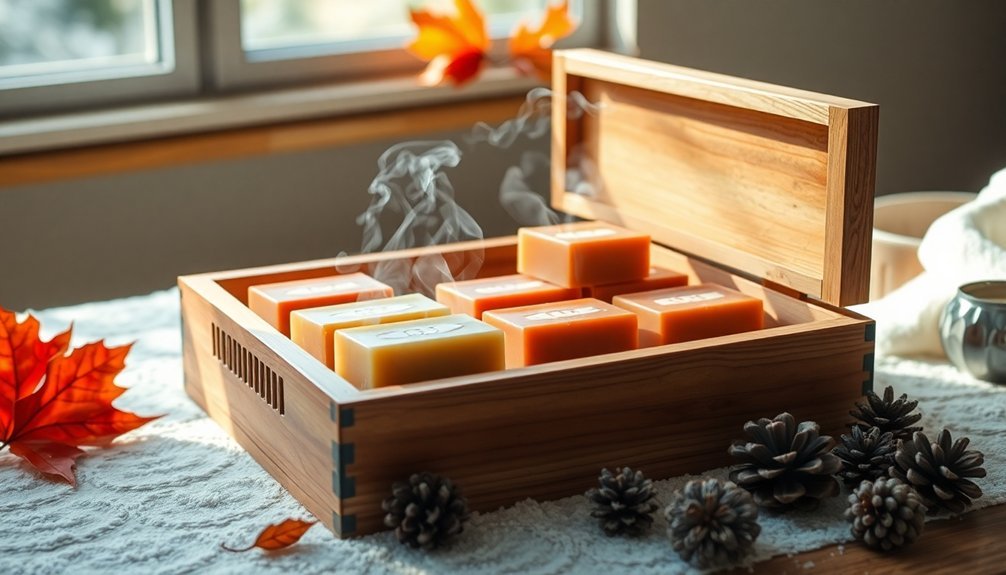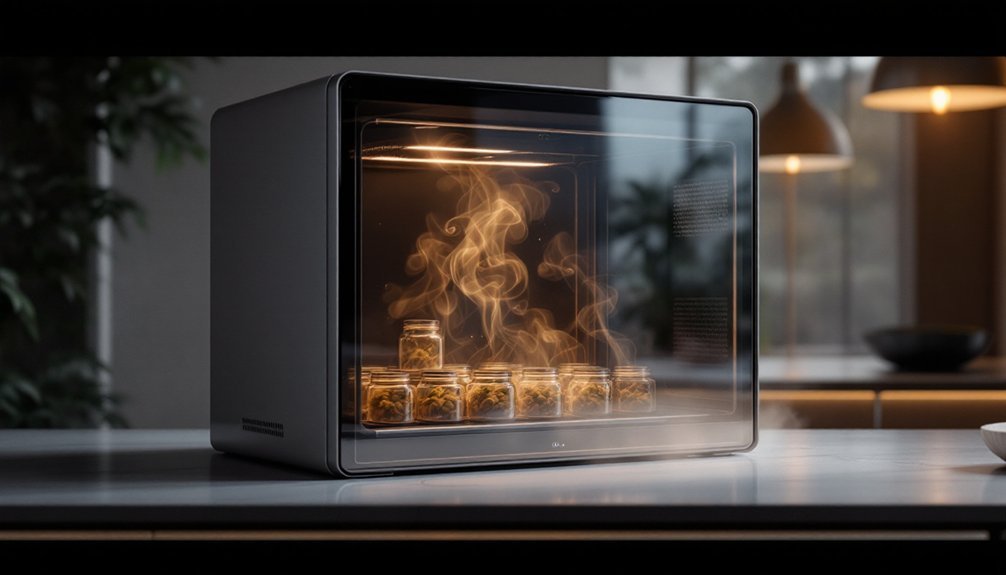For maximum airflow during soap curing, choose stackable ventilated trays like SoapEquipment's Vented Drying Trays or use wire racks that expose all sides of your bars. You'll want at least 1/2 inch spacing between soaps and consistent air circulation in a 65-75°F environment. DIY options include converted cardboard boxes with ventilation holes or repurposed bookshelves. Position your setup in a well-ventilated area away from direct sunlight. The right curing box can reduce curing time by up to 25%.
Understanding Airflow Requirements for Proper Soap Curing

While many soap makers focus on perfecting their recipes, proper airflow during curing is equally critical to creating quality soap. Your bars need consistent air circulation to properly evaporate excess water and develop their crystalline structure.
Ideal curing environments maintain temperatures between 65°F to 75°F with low humidity levels. Using a wire rack provides maximum air exposure to all surfaces of your soap bars during the crucial 4 to 6 week curing period. You'll want to position each bar with space between them, allowing air to flow freely around all surfaces. This separation prevents moisture buildup and promotes even drying.
Good airflow not only reduces your curing time but also enhances your soap's quality, creating a harder bar with better lather and longevity.
Without proper ventilation, excess moisture remains trapped, potentially causing bacterial growth and compromising your soap's integrity and shelf life.
Top Ventilated Curing Boxes for Handcrafted Soaps
When selecting equipment for your soap making workshop, ventilated curing boxes stand out as essential tools for quality production.
The best options feature slot vents that enhance air circulation around your soap bars, reducing curing time by up to 25% while ensuring consistent quality.
SoapEquipment's Vented Drying Trays offer stackable designs that maximize space efficiency without compromising airflow.
These food-grade polyethylene trays are built for durability and easy cleaning, making them ideal for both small batches and high-volume production. Creating an ideal writing environment for documenting your soap-making processes will help ensure consistent recipe replication and quality control.
- Transform your production capacity with systems that eliminate the need to rotate soap bars
- Reclaim valuable workspace with high-stacking capabilities
- Reduce your labor costs with designs that minimize handling requirements
- Protect your creations with materials that prevent moisture buildup and spoilage
DIY Solutions for Optimal Soap Curing Ventilation

Creating your own ventilation system for soap curing doesn't require expensive equipment or specialized tools. You can transform ordinary household items into effective curing stations with just a few modifications.
Start by converting cardboard boxes into ventilation chambers by cutting out sections for airflow. Metal racks or repurposed bookshelves provide excellent spacing between soap bars, while stacked milk crates offer a budget-friendly alternative.
Position your setup away from direct sunlight in well-ventilated areas like attics or basements. Enhance circulation by elevating soap bars on platforms and ensuring they don't touch each other. The ideal environment should maintain low humidity levels of approximately 45% for optimal curing results.
Add a small fan to increase air movement or use zeolite rocks to absorb excess moisture. Monitor humidity levels regularly and weigh your bars to track the curing progress—this helps you determine when they're perfectly ready for use.
How Material Choice Affects Air Circulation in Soap Containers
The material of your soap container plays an essential role in determining how well air circulates around your soap bars during the curing process. Non-absorbent materials like ceramic, stainless steel, and BPA-free plastic prevent water accumulation that can compromise your soap's quality.
Meanwhile, designs with proper drainage systems—featuring holes, slats, or raised platforms—enhance air flow and extend your soap's life by up to 30%.
- Feel the satisfaction of unwrapping perfectly cured soaps that maintain their texture and fragrance longer
- Imagine the pride of using environmentally responsible containers made from recycled materials
- Experience the relief of knowing your soaps aren't absorbing harmful chemicals from poor-quality containers
- Enjoy the beauty of natural materials like untreated wood or bamboo that complement your artisanal soaps
Seasonal Considerations for Soap Curing Box Ventilation

Your soap curing box needs different ventilation strategies as seasons change.
During summer, you'll want to combat heat with extra air circulation while preventing excessive evaporation that can crack your soap. Good air circulation is vital for proper curing and should be maintained 24/7 regardless of the season.
Winter requires careful humidity control through partial covering of ventilation holes and possibly a small dehumidifier to maintain ideal 45-55% humidity levels for proper curing.
Summer Heat Management
During summer months, managing heat becomes critical for soap makers who need to maintain ideal curing conditions. High temperatures can lead to "alien brains" on your soaps if you don't take proper precautions.
Setting up multiple fans to create constant airflow will considerably reduce ambient temperature while accelerating the curing process.
Consider integrating dehumidifiers into your setup, as they'll pull excess moisture from the air and create an excellent drying environment. Similar to how researchers in the Alpaca project utilize structured JSON data to analyze performance metrics, you can track temperature and humidity levels to optimize your curing process.
For extremely hot days, you might need to use refrigeration initially before moving soaps to your curing box.
- Watch your beautiful creations transform perfectly without heat damage
- Feel confident knowing your soaps are curing efficiently even in scorching weather
- Experience the satisfaction of professional-quality results year-round
- Eliminate the frustration of ruined batches due to summer heat problems
Winter Humidity Control
While summer heat poses one set of challenges, winter brings its own considerations for soap makers focused on proper curing.
Lower humidity levels during winter months can actually benefit your soap curing process, accelerating water evaporation and producing harder, more durable bars.
To maximize these benefits, design your curing box with adjustable ventilation features like mesh panels or slatted sides.
You'll want to maintain good airflow while preventing excessive dryness. Place your soap bars on raised platforms within the box and leave air gaps between them for ideal circulation.
Keeping soap in containers with proper airflow is better than using shrink wrapping materials which can trap moisture against the soap surface.
Consider adding a small dehumidifier or desiccant packets if your indoor heating creates inconsistent humidity levels.
Monitor both temperature and humidity regularly, as consistent conditions yield the best results.
With proper ventilation control, you'll turn winter's naturally lower humidity into an advantage for your soap making.
Preventing Common Airflow Problems in Traditional Soap Curing
To achieve perfectly cured soap bars, you'll need to overcome several airflow challenges that plague traditional curing methods.
Poor ventilation and overcrowded bars are common culprits behind unevenly cured soap that disappoints both you and your customers.
Implement these proven solutions to maximize airflow:
- Position a dehumidifier near your curing area to create the ideal drying environment, especially during humid seasons.
- Use mesh racks instead of solid surfaces to allow air circulation from all angles.
- Verify at least 1/2 inch spacing between bars to prevent moisture trapping.
- Install a small fan on low setting to maintain consistent air movement without accelerating moisture loss too rapidly.
Regular rotation of bars during curing further guarantees uniform results across your entire batch. Controlling ambient temperature is essential for preventing soap volcanoes that can occur when bars overheat during the curing process.
Frequently Asked Questions
How Long Do Concrete Specimens Need to Stay in a Curing Box?
You'll need to keep concrete specimens in a curing box for initial curing (1-2 days) before transport, followed by final curing for 28 days under controlled temperature and moisture conditions for proper strength development.
Can Curing Boxes Handle Both Cylindrical and Cube-Shaped Concrete Specimens?
Yes, most curing boxes can handle both cylindrical and cube-shaped concrete specimens. You'll find they're designed with versatile storage configurations to accommodate different sizes and shapes, ensuring proper curing for all your test samples.
What's the Difference Between Water-Bath Curing and Curing Box Methods?
Water-bath curing submerges objects underwater to reduce oxygen inhibition, while curing boxes use UV light in a controlled air environment. You'll find water baths are cheaper but less versatile than curing boxes for different resins.
Are Solar-Powered Curing Boxes Available for Remote Construction Sites?
Yes, you'll find solar-powered curing boxes specially designed for remote construction sites. They operate off-grid, provide consistent temperature control, and offer significant cost savings through renewable energy use despite some weather dependence.
How Do Digital Versus Analog Temperature Controls Affect Curing Precision?
Digital temperature controls offer superior precision for curing as they provide more accurate readings, better repeatability, and automated adjustments. You'll get more consistent results than with analog controls, which require more calibration and maintenance.
In Summary
You'll find that proper ventilation is the key to successfully cured soap. Whether you're using a commercial curing box or a DIY solution, remember that material choice and seasonal adjustments greatly impact your results. Don't let poor airflow ruin your handcrafted soaps—invest in quality curing solutions that promote circulation. With the right setup, you'll consistently achieve that perfect hardness and longevity your creations deserve.





Leave a Reply